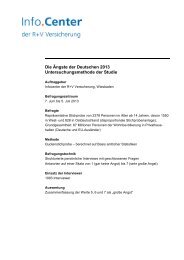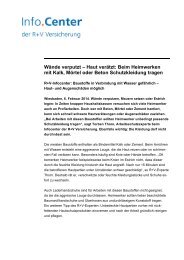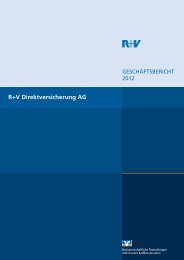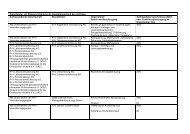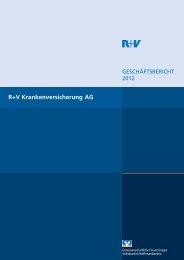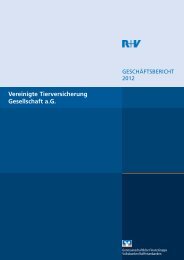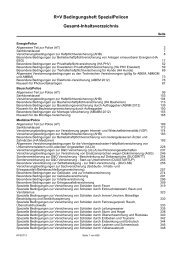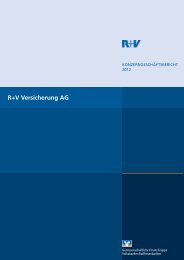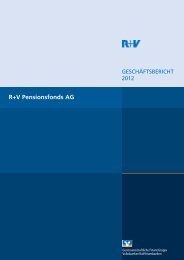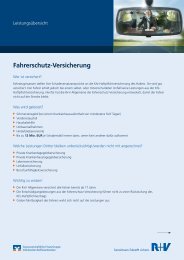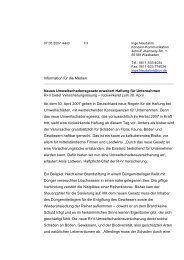Annual Report 2011 - R+V Versicherung
Annual Report 2011 - R+V Versicherung
Annual Report 2011 - R+V Versicherung
Create successful ePaper yourself
Turn your PDF publications into a flip-book with our unique Google optimized e-Paper software.
Management <strong>Report</strong> 4<br />
Business development and basic<br />
conditions<br />
YIELD FEDERAL GOVERNMENT BONDS – 10 YEARS RESIDUAL TERM<br />
in percent<br />
4.0<br />
3.5<br />
3.0<br />
2.5<br />
2.0<br />
1.5<br />
1.0<br />
2009 2010<br />
<strong>2011</strong><br />
The developments created a divided picture over the course<br />
of the year. Whilst limited optimism regarding the economic<br />
situation and the hope of a solution to the crisis still dominated<br />
in the first six months of the year, in the second six<br />
months, the capital market was defined by fears of recession<br />
and a deepening of the crisis. The ECB withdrew its interest<br />
rate increases. The interest rates for 10-year German government<br />
bonds halved during the course of the year falling to a<br />
historic low of just under 1.7% and only recovered slightly to<br />
1.8% by the end of the year. The divergence of interest rates in<br />
the eurozone countries increased significantly; the interest<br />
rates for ten-year government bonds in Italy increased temporarily<br />
to 7.2% and in Portugal to as high as 14.0%. Interest<br />
charges also increased significantly for all peripheral capital<br />
assets, first and foremost for bank bonds.<br />
These developments were also reflected on the equity markets.<br />
In the first six months of the year, the equity market index<br />
benchmark for the eurozone, EuroStoxx 50, fluctuated between<br />
2,700 and 3,100 points. It fell sharply between July and<br />
September, for a time by approximately one third, from a year<br />
high to a year low. At the end of year it stood at 2,316 points,<br />
thus showing a decline for the whole year of 18.4%. The DAX<br />
German share index fell by 15.6%.<br />
<strong>Annual</strong> Financial Statements 35 Further Information 62 9<br />
DEVELOPMENT STOCK INDEX EURO STOXX 50<br />
Index<br />
4,000<br />
3,500<br />
3,000<br />
2,500<br />
2,000<br />
1,500<br />
1,000<br />
2009 2010<br />
<strong>2011</strong><br />
Insurance business situation<br />
German insurers were able to show stable business trends in<br />
<strong>2011</strong> and, in spite of the continued worsening of the debt<br />
crisis in Europe, they only had to contend with slight losses in<br />
gross premium income. This decline is attributable primarily to<br />
the normalisation of one-off premium business that was<br />
sought after in the industry<br />
In life insurance, an increase in current new business premiums<br />
was accompanied by a decline in one-off premiums.<br />
Consequently, new business pushed ahead of current premiums<br />
by 8.2%. Conversely, following extremely strong growth<br />
in the preceding years, one-off premiums fell by one sixth from<br />
26.8 to 22.4 bn euros. Overall, the life insurers generated gross<br />
premiums of 86.6 bn euros, a fall of 4.2%. The cancellation<br />
ratio fell again according to GDV and now concerns approximately<br />
3.5% of policies.<br />
Private health insurers continued their growth course and<br />
recorded an increase in premiums of 4.9% to 34.9 bn euros.<br />
Approximately 32.8 bn euros were applicable to comprehensive<br />
and supplementary insurance and 2.1 bn euros to long-term<br />
care insurance.



